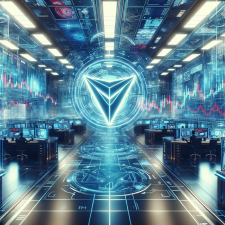Bitcoin and other cryptocurrencies once found a goldmine in using graphics processing units (GPUs) for mining. Efficiently tackling hashing algorithms made GPUs indispensable for mining setups, resulting in skyrocketing prices and a notable scarcity of mining-ready graphics cards.
A unique chapter is highlighted, where cryptocurrency mining brought enormous profits to both miners and GPU producers, alongside a GPU shortage. Moreover, a glimpse into the potential interplay between blockchain and GPUs in the future is provided.
The surge in cryptocurrency values prompted a significant increase in GPU demand, enhancing sales for manufacturers. With the decline in mining profitability, the role of GPUs in the crypto industry has diminished. Nonetheless, blockchains still harness GPU power, given various applications that benefit from distributed computational capability.
In 2016, a cryptocurrency surge drew the attention of entrepreneurs, businesses, and investors alike. Mining turned into an enticing profit generator, inviting those with idle computer resources to dive in. As participation grew, mining difficulties escalated due to the pre-set configurations of popular cryptocurrency blockchains. CPUs, once capable of mining, soon fell behind as processing needs soared.
Soaring values in the cryptocurrency sphere further drew in users, motivating a shift from traditional home computing setups to specialized rigs boasting enhanced hashing power through multiple GPUs. Machines dedicated solely to mining emerged, sometimes sporting over eight graphics cards working in harmony to crack cryptographic puzzles.
The escalating demand for more robust mining machines triggered significant disruptions within the GPU and computer component market spaces. By 2016, a GPU shortage was palpable as gamers and designers struggled to find available units from standard retailers. By 2017’s mid-year, the market felt the strain as miners rapidly purchased GPUs, outpacing production capabilities.
Even modest-tier graphics cards had their prices soar, prompting retailers like eVGA and NewEgg to introduce measures preventing single-user bulk purchases. For instance, eVGA implemented a waiting list, while NewEgg adopted a similar approach.
Quick Insight
Widespread GPU shortages were not limited to retail consumers; research sectors, too, faced hurdles as scientists in disciplines like astronomy, genetics, and mathematics found it challenging to acquire necessary graphics cards for their advanced computations.
Beyond mining, blockchain and GPUs crafted an ideal synergy. Offering distributed networks, blockchain disperses computational power, yielding “virtual supercomputers” reliant on network-wide strength. Additionally, the growing appetite for computing-as-a-service, alongside cloud computing and the GPU-as-a-service sectors, highlights a rising demand.
Major tech players have begun providing these services, although centralization limits their efficiency. With services available from giants like Google Cloud, Amazon Web Services, and Nvidia, the market is competitive.
Innovative companies are developing platforms leveraging blockchain for distributed GPU power. The Render Network, for instance, utilizes the Solana blockchain alongside proprietary cloud rendering tools to align computation needs with GPU rendering capabilities.
Clore.AI offers a platform allowing users to host GPUs for rent to those needing extra power for AI, mining, or rendering tasks. Neura, a blockchain designed for AI, boasts a network of GPU hosts. The company asserts that its platform facilitates “launching and scaling AI with adaptable, cost-effective, on-demand computing.”
In the tech landscape, AI is melding with blockchain and cryptocurrency. Should concepts like Neura gain traction among businesses, developers, and investors, the demand for GPUs in blockchain projects may once again rise, given their superior speed over CPUs for complex computational tasks.
Understanding the GPU Industry
Encompassing GPU producers, the graphics processing unit industry finds applications in numerous devices needing to translate signals and data for display purposes, such as monitors and other screens. Their speed also renders them vital in artificial intelligence, machine learning, and analytics.
Decoding GPUs in Blockchain
Due to greater data processing speeds, GPUs find roles in blockchain applications for transaction validation and related tasks.
While GPUs once catalyzed a revolutionary shift in the industry through blockchain, as of October 2024, mining is no longer profitable with GPUs. Nonetheless, emerging blockchain applications for GPUs continue to surface, leveraging distributed GPU power for more sophisticated and efficient task execution than singular devices or networks.
Crypto Mining’s Affinity with GPUs
Historically, crypto miners favored GPUs for their superior speed over alternative methods. However, the present competitive mining landscape renders GPUs unprofitable for most lucrative cryptocurrencies.







